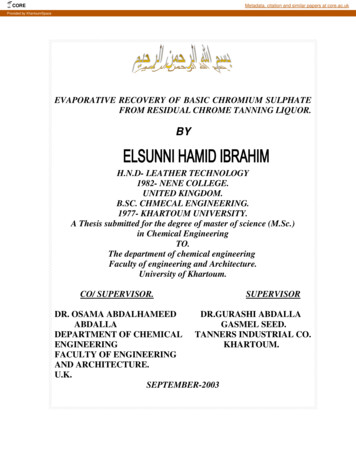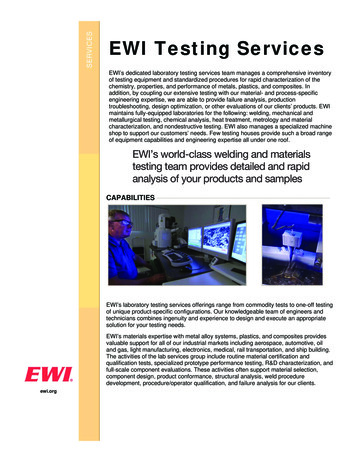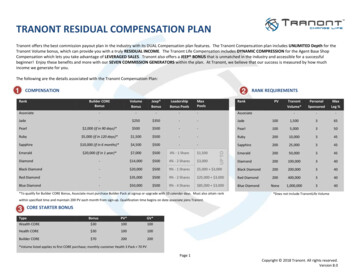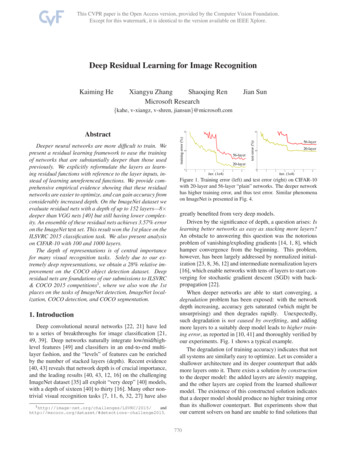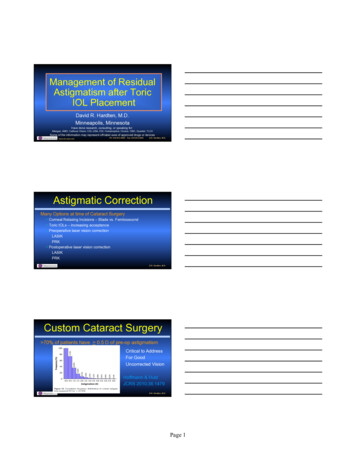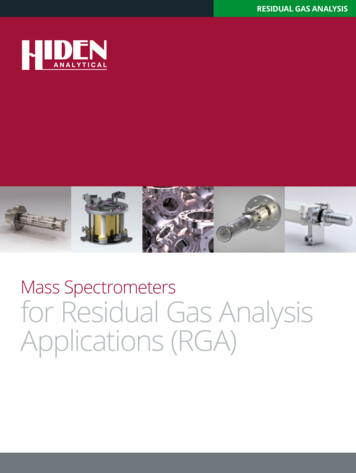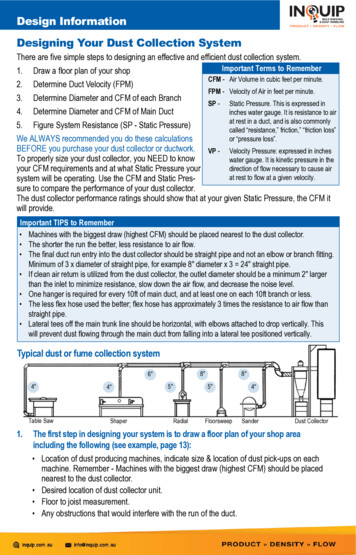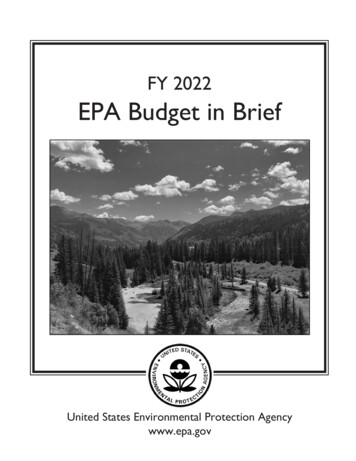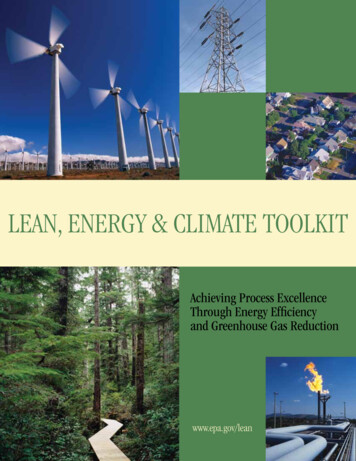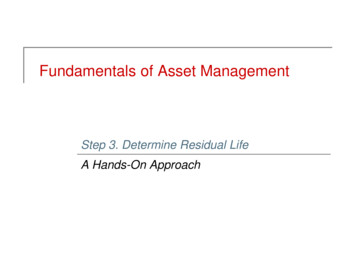
Transcription
Fundamentals of Asset ManagementStep 3. Determine Residual LifeA Hands-On Approach
Tom’s bad day Fundamentals of Asset Management2
First of 5 core questions, continued1.What is the condition of my assets? How well do theyperform? What is the importance of remaining useful life?How might we determine remaining useful life?Fundamentals of Asset Management3
AM plan 10-step processExpected LifeTables;Decay Curves1. What is the current state of my re ModesDetermineResidualLifeDetermineLife Cycle &ReplacementCostsSet TargetLevels ofService (LOS)DetermineBusiness zeCapitalInvestmentDetermineFundingStrategyBuild AMPlanFundamentals of Asset Management4
Determining Residual LifePerformanceCurrent aining Service LifeNowFundamentals of Asset ManagementTime (years)5
But – when has an asset ―failed‖? When it cannot do what it is required to doTechnical perspective – when the asset is not―available‖: When the asset stops functioning or does not function whencalled on When performance deteriorates to point of insufficient service When it is taken out of service (maintenance, renewal) Does your maintenance management businessprocess (think work order) identify when an asset goesout of service and when service is restored?Thought exercise: when exactly has a sewer pipe―failed‖?Fundamentals of Asset Management6
What do we mean by ―remaining asset life‖?X End of financial life – when an asset is fully financiallydepreciated on the ―books‖ End of physical life – when an asset is physically nonfunctioning (e.g., failed, collapsed, stopped working) End of service level/capacitylife – when an asset canno longer do what we/our customers/stakeholdersrequire it to do End of economic life – when an asset ceases to be thelowest cost alternative to satisfy a specified level ofperformance or service levelFundamentals of Asset Management7
The role of failure modes in determining residual lifeDecision IssuesIs capacityan issue?StartFailure ModeYesLikely beforeother modes?YesYesLikely beforeother modes?YesYesLikely beforeother modes?YesYesLikely beforeother modes?YesRemainingLifeCapacity18 monthsLOS3 yearsMortality10 yearsNoHas LOSchangedfrom design?NoIs physicalreliabilityan issue?NoRedo—it hasto failsomehowNoIs costto operatean issue?Fundamentals of Asset ManagementEfficiencyNow8
Key definition: ―effective asset life‖ ―Effective asset life‖ is the lowest expected life for aselected asset given its operating environment wherethat life is derived from a determination of the mostimminent trigger among the three asset life triggers(service level life, capacity life, physical life, economiclife). Example (remaining life): service level/capacitylife – 3 breaks, estimated 2 years to nextbreak (―no more than 4 breaks in 5 years‖) Physical life – 30 years Economic life – 10 yearsFundamentals of Asset Management9
Determining remaining physical lifeAge Based Approach 1 Effective life tableApproach 2 Effective life table, plus modificationfactorsApproach 3 Direct observation tableApproach 4 Condition and decay curve tableCondition BasedFundamentals of Asset Management10
Approach 1, effective life table (―design life‖)ClassAsset TypeEffectiveLifeClassAsset TypeEffectiveLife1Civil756Motors352Pressure 409Building assets305Valves3010LandNASources: manufacturers, industrial associations, GASB, colleagues, consulting engineers,research (professional associations, universities), international communityFundamentals of Asset Management11
So, how do we move forward - review:―Percent of effective life consumed‖conceptDecay or failure curveClusterMinimumPoorPerformanceExcellentData distribution of asset conditionPhysical Failure0255075Percent of Effective Life ConsumedFundamentals of Asset Management10012
Example: simple determination of ―% remainingphysical life‖1.Calculate physical life consumed% physical lifeconsumed2. Life to dateEstimated useful lifeDetermine % remaining physical life% remainingphysical life 1.0 – % physical life consumedExample calculation - % remaining physical lifeAsset acquired 1992; current year 2012; useful life 25 years20% remainingphysical lifeFundamentals of Asset Management 1.0 – (20 yr. LTD / 25 yr. EUL)13
Approach 2, amending standard effective livesDesign life*From impacts that reduce lifeDiminished Effective LifeAsset Design LifeEnhanced Effective LifeFrom impacts that increase lifeDecreasingTimeIncreasing*Asset design life is from average effective life tablesFundamentals of Asset Management14
Modification factors for effective life tablesImpact Rating FactorCondition Variables12345Design standards 10% 5%0-5%-10%Construction quality 10% 5%0-5%-10%Material quality 10% 5%0-5%-10%Operational history 10% 5%0-5%-10%Operating environment 10% 5%0-5%-10%External stresses 10% 5%0-5%-10%Fundamentals of Asset Management15
Approach 3: ―Direct observation‖ tableAssessment (Likelihood ofOccurrence within One YearDescriptionAlmost certainExpected to occur within 1 yearVery highLikely to occur within 1 yearHighEstimated 50% chance of occurring withinany yearQuite likelyExpected to occur within 5 years; estimated20% chance of occurring in any yearModerateExpected to occur within 10 years;estimated 10% chance of occurring in anyyearLowExpected to occur within 50 yearsVery lowExpected to occur within 100 yearsFundamentals of Asset Management16
Challenge: Age versus condition based renewalSame Age!Courtesy of Manatee CountyTod Phinney, P.E.John Paterson, Ph.D., P.E., BCEEFundamentals of Asset Management17
Strategy: Condition based rather than age based Assess condition of targeted cast iron and ductile ironforce mains using sonar technologyConduct failure analysis to understand failure modesFocus only on assessment of those (short) sections offorce main that are likely in worst condition (highpoints where pipes rise)Use work orders and GIS to locate candidate sectionsAssess condition in one day or lessFundamentals of Asset Management18
In the trenches Fundamentals of Asset ManagementCourtesy of Manatee CountyTod Phinney, P.E.John Paterson, Ph.D., P.E., BCEE19
Results: Manatee County, Florida Courtesy of Manatee CountyTod Phinney, P.E.John Paterson, Ph.D., P.E., BCEECondition assessments were programmed for 14 forcemains that were already programmed for replacement(combined total length – 12 miles)Immediate replacement was not required for 90% (bylength); stately alternatively – 90% of pipe scheduledfor replacement based on age had useful service lifeleft.Reduced CIP by 5.5 millionDelayed an additional 2 million pending conditionassessment in lieu of replacementFundamentals of Asset Management20
Approach 4, Condition assessment and thedecay curveCondition assessment assists inrecognizing Nature and shape of thefailure or decay (ordeterioration) curve Where on the curve is asset’scurrent condition Asset’s remaining useful life,an estimateFundamentals of Asset Management21
Developing a decay curve Longitudinal study—usesdata collected over the life ofa single asset (or set ofassets)Latitudinal study—uses datacollected from multiple assetsof the same type but ofdifferent agesFundamentals of Asset Management22
Challenge: tying condition score and %physical life consumedRelating asset condition to percent of physical life consumed57910Performance3Decay or failure curveMinimumPoorCondition1ExcellentData distribution of asset conditionPhysical Failure0255075Percent of Effective Life ConsumedFundamentals of Asset Management10023
Alternative: tying condition score to asset failure8Decay or failure nData distribution of asset conditionPhysical Failure020406080100Percent of Effective Life ConsumedFundamentals of Asset Management24
Alternative: tying condition to remaining lifeusing % Physical Life Consumed% of PhysicalLife ConsumedCondition entals of Asset Management25
Enter: ―management strategy groups‖ Grouping of assets with similar renewal / behavioralpatternsPurpose - to assist: Assigning asset lives and decay curves Calculating current replacement costs Calculating risk Consequence of failure Probability/likelihood of failure Developing life-cycle management plans Examples Gravity Pipes, RCP, Built 1950, in High H2S areas Submersible sewage pumps, ABC Co., 123 series, 1983 1995Fundamentals of Asset Management26
Key points from this sessionWhat is its remaining life?Key Points: Determining remaining useful life isas much art at this point as scienceAlthough good information is better,asset ―decay curves‖ need not behighly detailed to be useful.Good CMMS data is key to buildingagency specific failure curvesGood condition information is vital toassigning remaining useful lifeIncorporating good failure codes intothe work order is important tobuilding good failure curvesFundamentals of Asset ManagementAssociated Techniques: Remaining useful life assessment·Decay curves, useful-life tablesSurvivor curvesMajor failure modes27
Tom’s spreadsheetFundamentals of Asset Management28
Key definition: ―effective asset life‖ ―Effective asset life‖ is the lowest expected life for a selected asset given its operating environment where that life is derived from a determination of the most imminent trigger among the three asset life triggers (service level life, capacity life, physica
